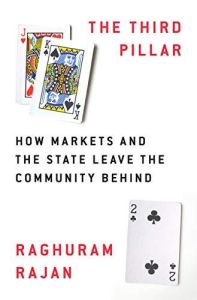Join getAbstract to access the summary!

Join getAbstract to access the summary!
Raghuram Rajan
The Third Pillar
How Markets and the State Leave the Community Behind
Penguin Press, 2019
What's inside?
Across many advanced economies, market forces have run roughshod over communities.
Recommendation
Across many advanced economies, market forces have run roughshod over communities, noted economist Raghuram Rajan argues in this study of globalization. He details a familiar litany of woes – manufacturing jobs lost, the rise of populism and voters scapegoating immigrants. Refreshingly, though, Rajan takes a middle-of-the road path, calling out both leftists and rightists for positions he considers misguided. He also offers some important solutions, but as intriguing as those ideas are, it’s unclear how much traction those positions might gain in today’s polarized economic politics.
Summary
About the Author
Raghuram Rajan is a finance professor at the University of Chicago. He was the governor of the Reserve Bank of India and chief economist at the International Monetary Fund.


















Comment on this summary